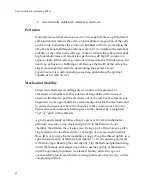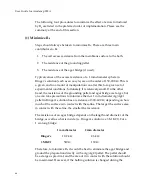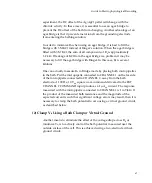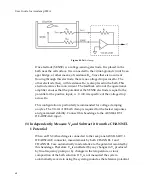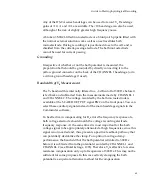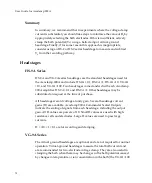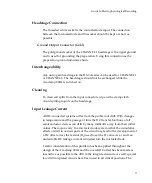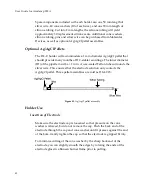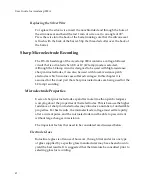
Guide
to
Electrophysiological
Recording
Any
of
the
HS
‐
9A
series
headstages
can
be
used
to
record
V
b
.
Headstage
gains
of
×10,
×1
and
×0.1
are
suitable.
The
×10
headstage
can
also
be
used,
although
at
the
risk
of
slightly
greater
high
frequency
noise.
A
broken
3
M
KCl
‐
filled
microelectrode
or
a
blunt
patch
pipette
filled
with
the
normal
external
solution
works
well
as
an
extracellular
bath
microelectrode.
During
recording
it
is
positioned
close
to
the
cell,
and
is
shielded
from
the
current
‐
passing
electrode.
The
bath
microelectrode
cannot
be
used
for
current
passing.
Grounding
Irrespective
of
whether
or
not
the
bath
potential
is
measured,
the
preparation
bath
should
be
grounded
by
directly
connecting
it
to
the
yellow
ground
connector
on
the
back
of
the
CHANNEL
1
headstage
(or
to
a
virtual
‐
ground
headstage
if
used).
Bandwidth
of
V
b
Measurement
The
V
b
bandwidth
is
internally
filtered
to
a
–3
dB
cutoff
of
300
Hz
before
it
is
fed
back
and
subtracted
from
the
measurements
made
by
CHANNEL
1
and
CHANNEL
2.
The
voltage
recorded
by
the
bath
microelectrode
is
available
at
the
SCALED
OUTPUT
signal
BNC
on
the
front
panel.
You
can
select
these
auxiliary
signals
instead
of
the
main
headstage
signals
in
the
Commander
software.
To
be
effective
in
compensating
for
R
s
errors
the
frequency
response
of
a
bath
voltage
electrode
should
match
the
voltage
recording
electrode
frequency
response.
At
the
same
time
it
is
most
important
for
the
bath
voltage
signal
to
be
appropriately
attenuated
at
high
frequencies,
since
this
signal
is
not
inverted
and,
thus,
presents
a
positive
feedback
pathway
that
can
potentially
destabilize
the
clamp.
For
optimum
voltage
‐
clamp
performance,
the
bandwidth
of
the
bath
potential
is
limited
to
300
Hz
before
it
is
subtracted
from
the
potentials
recorded
by
CHANNEL
1
and
CHANNEL
2
(see
Finkel
&
Gage,
1985).
Therefore
V
b
is
effective
for
series
resistance
compensation
only
up
to
frequencies
of
300
Hz.
This
may
not
be
sufficient
for
some
purposes.
In
this
case
actively
clamping
the
bath
potential
is
a
superior
alternative
method
for
R
b
compensation.
69






